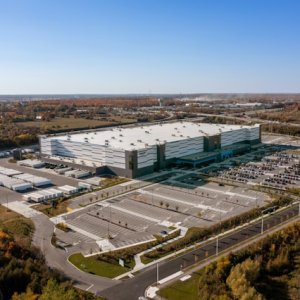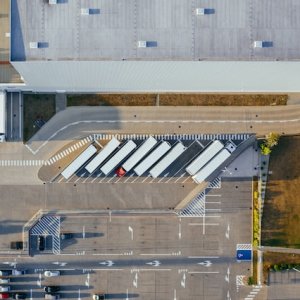
Pandemic, Nearshoring Raise Industrial, Logistic Demands
 By Cas Biekmann | Journalist and Industry Analyst -
Tue, 11/09/2021 - 13:16
By Cas Biekmann | Journalist and Industry Analyst -
Tue, 11/09/2021 - 13:16
You can watch the video of this presentation here.
With the economic recovery seemingly in full swing, the growing demand for nearshoring manufacturing and logistics-focused activity provides Mexico’s industrial parks with plenty of demand. Adapting to current needs is essential to attract these new players, argue industry experts, but this shift should also align with optimal investment attraction strategies.
“The real estate market for industrial and logistics players has been one of the winners of the pandemic, although seeing markets in terms of winners and losers is too simple because they are all intertwined,” said Claudia Ávila, Executive Director, Mexican Association of Industrial Parks (AMPIP). Two main drivers are pushing demand in the market: the growing need for nearshoring to outsource manufacturing or logistics to Mexico, as well as the spectacular growth of e-commerce. Ávila mentioned that the latter industry has experienced a whopping percent 81 growth from 2019 to 2020, according to a report from the Mexican Association of Online Sales (AMVO). Overall, e-commerce now represents up 9 percent of all sales made. Growth in nearshoring might not be as explosive but the growing demand, thanks to Mexico’s excellent position and market fundamentals, can no longer be ignored. The uptick causes significant challenges to solve for companies providing industrial infrastructure.
“We are experiencing record growth in the industry,” said Enrique Lavin, Country Head, PGIM Mexico, the local arm of a leading global real estate manager and administrator. “Nearshoring is a reality, we see that it is increasing 15 percent year-by-year for industrial parks and logistic centers,” he added, noting that most players settling in the Mexican market tend to come from the US and Asia. But neither manufacturing nor logistics are standing still. Both are moving with current trends such as sustainability, environmental responsibility, digitalization and the use of electric vehicles (EVs), many of these trends having some form of overlap. Health and safety concerns have also increased significantly since the start of the COVID-19 pandemic.
“Adaptability to new challenges and trends is key,” said Juan Rodrigo Vega, Chief Marketing Manager, CONSTRUCTORA INSUR. Investment volume in 3Q21 hit a record high, reaching US$193 billion, according to infrastructure giant Newmark’s 3Q21 Capital Markets Report. In the current market, investors are looking for higher efficiency: “It is necessary to address challenges from industrial players looking to become more efficient,” said Jorge Fabris, Newmark’s Managing Director.
Though adaptation is essential for the success of real estate companies, the shift to client demand should go hand in hand with attracting foreign direct investment (FDI). Because Mexico is widely recognized as a force in manufacturing, with an excellent workforce to boot, the country is well-positioned to attract such capital. In fact, Mexico is one of the world’s top locations for FDI. “During events and panels, people on the outside often see Mexico as a potential winner. We are in a privileged position to make good use of growing demand,” said Fabris. “Mexico has one of the highest CAP Rates, between 6 and 7 percent, whereas the US has between 3.5 and 4.5 percent. This is a difference of 250-300 base points. These figures attract foreign capital to Mexico,” said Luis Gutiérrez, President, Prologis Latin America
As a result of increased demand for e-commerce, more storage and inventory space is a must for companies in Mexico. “Changes in consumption patterns and logistic needs have altered how we see the industry,” explained Gutiérrez. Especially in the North of Mexico, storage space is becoming an issue, driving up land prices. “Storage and logistics practices are changing from a ‘just in time logistics’ to ‘just in case storage’ approach,” said Gutiérrez, which further compounds the problem. Higher rents and increased land prices create problems. “This limits growth,” said Lavin.
Finding Solutions to Position Mexico as a Winner
No matter the solution, Mexico should move quickly to solve issues regarding space and workforce. “Potential clients have no time to wait,” stressed Ávila. “This is indeed a challenge, but is a positive issue for developers because it forces them to be in touch with current demands,” replied Fabris.
To deal with a lack of storage space, plenty of solutions are already available and merely need to be implemented correctly. “Because saturation is an issue, companies should consider going vertical instead of expanding horizontally,” suggested Vega. This means higher buildings, operating on an equally elevated level of efficiency. Converting Class B buildings to warehousing can provide more value, said Fabris. Older, unused manufacturing plants are often located in well-connected sites and become beneficial again by serving as storage spaces. What is more, green energy solutions such as photovoltaic solar panels could be installed on older buildings.
Human resources pose the next big challenge for Mexico’s industrial players. Especially after a global pandemic, international companies have found that attracting the right workforce is an issue. “Mexico’s human resources are an asset, so the country stands a lot to gain here,” said Gutiérrez. But these resources have remained somewhat underdeveloped. “We are still somewhat behind developed economies in terms of infrastructure as well as in the training of human resources,” said Vega. “Mexico has one of the best workforces in the world, but the public and private sector should develop its potential,” he added. Via improved universities and training centers, Mexico’s workers can begin to better tackle the challenges of modern logistics and automation. “The biggest challenge is to develop joint platforms with the government to offer long-term solutions,” said Lavin.
Mexico’s northern and center areas are quite well developed, but Mexico’s south has traditionally not enjoyed as much growth. By making use of the growing need for industrial infrastructure, this trend can change. “There is real industrial growth in southern Mexico, especially for storage facilities. We see that this area has great potential for this type of growth development,” said Vega. Fabris added that southeast Mexico has attracted attention from international clients, “particularly in Merida, Villahermosa and Veracruz.”















